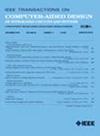螺旋+:用于芯片间链路验证的高效信号功率完整性联合分析
IF 2.9
3区 计算机科学
Q2 COMPUTER SCIENCE, HARDWARE & ARCHITECTURE
IEEE Transactions on Computer-Aided Design of Integrated Circuits and Systems
Pub Date : 2025-01-22
DOI:10.1109/TCAD.2025.3532822
引用次数: 0
摘要
芯片技术最近成为一种有前途的解决方案,通过高速芯片间串行链路促进复杂设计的模块化和通信来提高芯片性能。然而,这些链路的封装上路由密度和数据速率的增加带来了复杂的信号和功率完整性挑战,超过了传统大型单片芯片所遇到的挑战。使用有效的分析和设计工具处理这些复杂性对于保持设计健壮性至关重要。在本文中,我们提出了用于高速片间串行链路验证的螺旋+:信号功率完整性联合分析框架。该框架采用机器学习(ML)构建发射器模型,并利用脉冲响应提取方法对信道和接收器建模。然后,利用开发的等效模型,通过一种新的基于双边缘响应的方法执行信号功率完整性联合分析。此外,设计了一个高效的ML模型来准确预测眼图指标。该分析为设计优化提供了有价值的见解。实验结果表明,SPIRAL+实现眼图的平均相对误差为0.07% ~ 7.47%,同时实现了比传统商业工具31倍~ 326倍的加速。本文章由计算机程序翻译,如有差异,请以英文原文为准。
SPIRAL+: Efficient Signal–Power Integrity Co-Analysis for Interchiplet Links Validation
Chiplet technology has recently emerged as a promising solution to improving chip performance through the modularization of complex designs and communication facilitated by high-speed interchiplet serial links. However, the increasing on-package routing density and data rates of these links introduce complex signal and power integrity challenges, surpassing those encountered in traditional large monolithic chips. Addressing these complexities with efficient analysis and design tools is crucial for maintaining design robustness. In this article, we propose SPIRAL+: signal-power integrity co-analysis framework for high-speed interchiplet serial links validation. The framework employs machine learning (ML) to construct transmitter models and utilizes an impulse response extraction method for modeling the channel and receiver. It then performs signal-power integrity co-analysis through a novel double-edge response-based method, leveraging the developed equivalent models. Additionally, an efficient ML model is crafted to accurately predict eye diagram metrics. The analysis provides valuable insights for design optimization. Experimental results show that SPIRAL+ achieves eye diagrams with a mean relative error of 0.07%–7.47%, while realizing a speedup of $31\times $ – $326\times $ over traditional commercial tools.
求助全文
通过发布文献求助,成功后即可免费获取论文全文。
去求助
来源期刊
CiteScore
5.60
自引率
13.80%
发文量
500
审稿时长
7 months
期刊介绍:
The purpose of this Transactions is to publish papers of interest to individuals in the area of computer-aided design of integrated circuits and systems composed of analog, digital, mixed-signal, optical, or microwave components. The aids include methods, models, algorithms, and man-machine interfaces for system-level, physical and logical design including: planning, synthesis, partitioning, modeling, simulation, layout, verification, testing, hardware-software co-design and documentation of integrated circuit and system designs of all complexities. Design tools and techniques for evaluating and designing integrated circuits and systems for metrics such as performance, power, reliability, testability, and security are a focus.

 求助内容:
求助内容: 应助结果提醒方式:
应助结果提醒方式:


